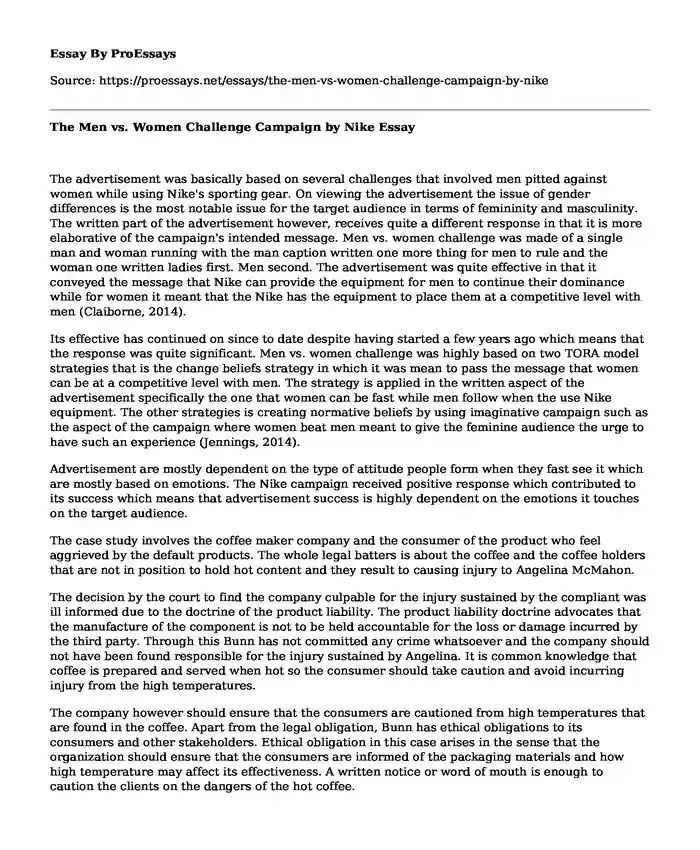The advertisement was basically based on several challenges that involved men pitted against women while using Nike's sporting gear. On viewing the advertisement the issue of gender differences is the most notable issue for the target audience in terms of femininity and masculinity. The written part of the advertisement however, receives quite a different response in that it is more elaborative of the campaign's intended message. Men vs. women challenge was made of a single man and woman running with the man caption written one more thing for men to rule and the woman one written ladies first. Men second. The advertisement was quite effective in that it conveyed the message that Nike can provide the equipment for men to continue their dominance while for women it meant that the Nike has the equipment to place them at a competitive level with men (Claiborne, 2014).
Its effective has continued on since to date despite having started a few years ago which means that the response was quite significant. Men vs. women challenge was highly based on two TORA model strategies that is the change beliefs strategy in which it was mean to pass the message that women can be at a competitive level with men. The strategy is applied in the written aspect of the advertisement specifically the one that women can be fast while men follow when the use Nike equipment. The other strategies is creating normative beliefs by using imaginative campaign such as the aspect of the campaign where women beat men meant to give the feminine audience the urge to have such an experience (Jennings, 2014).
Advertisement are mostly dependent on the type of attitude people form when they fast see it which are mostly based on emotions. The Nike campaign received positive response which contributed to its success which means that advertisement success is highly dependent on the emotions it touches on the target audience.
The case study involves the coffee maker company and the consumer of the product who feel aggrieved by the default products. The whole legal batters is about the coffee and the coffee holders that are not in position to hold hot content and they result to causing injury to Angelina McMahon.
The decision by the court to find the company culpable for the injury sustained by the compliant was ill informed due to the doctrine of the product liability. The product liability doctrine advocates that the manufacture of the component is not to be held accountable for the loss or damage incurred by the third party. Through this Bunn has not committed any crime whatsoever and the company should not have been found responsible for the injury sustained by Angelina. It is common knowledge that coffee is prepared and served when hot so the consumer should take caution and avoid incurring injury from the high temperatures.
The company however should ensure that the consumers are cautioned from high temperatures that are found in the coffee. Apart from the legal obligation, Bunn has ethical obligations to its consumers and other stakeholders. Ethical obligation in this case arises in the sense that the organization should ensure that the consumers are informed of the packaging materials and how high temperature may affect its effectiveness. A written notice or word of mouth is enough to caution the clients on the dangers of the hot coffee.
References
Claiborne, C. B., & Sirgy, M. J. (2015). Self-image congruence as a model of consumer attitude formation and behavior: A conceptual review and guide for future research. In Proceedings of the 1990 Academy of Marketing Science (AMS) Annual Conference (pp. 1-7). Springer International Publishing.
Jennings, M. (2014). Business: Its legal, ethical, and global environment. Nelson Education.
Shaw, W., & Barry, V. (2015). Moral issues in business. Cengage Learning.
Solomon, M. R. (2014). Consumer behavior: buying, having, and being. Engelwood Cliffs, NJ: Prentice Hall.
Cite this page
The Men vs. Women Challenge Campaign by Nike. (2021, May 17). Retrieved from https://proessays.net/essays/the-men-vs-women-challenge-campaign-by-nike
If you are the original author of this essay and no longer wish to have it published on the ProEssays website, please click below to request its removal:
- Marketing Assignment: Packaging
- Case Study Around the Fundamentals of Project Management
- Critical Evaluation of the Human Resource Strategy of Goody's LLC
- The Business Case for Diversity Paper Example
- Apple SWOT Analysis Paper Example
- The Mutual Effect Between Risk and Project Cost Management Essay Example
- Paper Example on Gel Brand: Empowering Men's Grooming with Doblix







